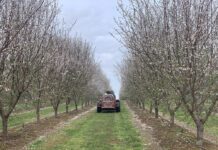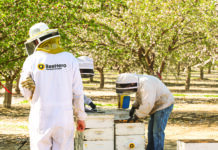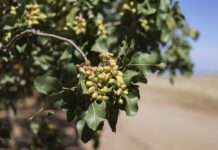
With world tree nut production now at 12.5 billion pounds, up 5 billion pounds from 10 years ago, and with many supply channels full, finding export markets for California tree nuts has never been more important.
Against that backdrop, the industry is facing multiple challenges, including retaliatory tariffs in China and Turkey, regulatory constraints on tree nut exports in the EU and a strong U.S. dollar that is putting the price of tree nuts out of reach for some consumers.
On the bright side, the lifting of retaliatory tariffs on almonds and walnuts in India last year was a significant development; one dampened, however, by the fact that U.S. almonds still face a significant disadvantage when compared to Australian almonds. Australia, which has a free-trade agreement with India, pays half of the duty U.S. almonds pay, or 17.5 rupees/kg., compared to 35 rupees/kg. for U.S. almonds.
California walnuts, meanwhile, face the same tariff as other countries when exporting to India, but at 100%, the added cost can still put a dent in sales in part because of the already high cost of U.S. tree nuts, a cost inflated by the strong U.S. dollar, which is proving a detriment in many foreign markets.
“The strong U.S. dollar is affecting consumers’ purchasing power no matter what country you live in,” said Pam Graviet, vice president of integrated marketing for the California Walnut Board and Commission.
Aubrey Bettencourt, president and CEO of the Almond Alliance, agreed. “A couple years ago, with the supply chain totally dysfunctional, we joked we could sell the almonds, but we couldn’t ship them,” she said. “This last year, the defining issue was, ‘Well we could ship the almonds, but we couldn’t sell them globally.’ And economics played a huge part in that. A strong dollar makes it difficult to export to any country.”
Still, Bettencourt pointed out almond exports grew considerably as 2023 progressed with more than 30 million pounds shipped in December, a near record level for the month. “We are optimistic because of that, and we are hoping that uptick is going to continue into 2024,” Bettencourt said.
Similarly, Graviet said 2023 walnut exports were up 17% over 2022 through the end of January. Some of that increase can be attributed to the lifting of the retaliatory tariff in India, she said, and a larger part to crop quality.
“The 2022 crop had some damage due to an extreme heat wave just before harvest,” Graviet said. The 2023 crop, meanwhile, was “one of the best quality crops we’ve seen in a number of years, not only in color but in taste and size and texture. Mother Nature was not nice in 2022, but she made up for it in 2023, and the market has responded.”
Fits and Starts
Tree nut industry executives said while the industry has made some gains in addressing trade barriers in recent years, it has not done as well as it would have liked. During the Almond Board of California Conference in early December, for example, both Julie Adams, vice president of global technical and regulatory affairs for ABC, and Jonathan Hoff, chairman of ABC’s Global Technical Regulatory Affairs Committee, said it often felt like the industry was taking one step forward and two steps back in addressing global trade barriers. One example: While the industry made progress in India last year, it lost ground in Turkey.
Bettencourt agreed: “We saw great progress last year with India,” she said, “but we then turn around and saw Turkey increase their duty and tariff on almonds up to 25%. And so, we’ve been working very diligently to address that.”
The development included a 15% increase in tariffs on U.S.-grown almonds above the previously imposed retaliatory tariff of 10%.
The same is true for the California walnut industry, which saw Turkey increase its tariff on walnuts from 4% to 15% with the 10% retaliatory tariff still in place.
Addressing the tariff on almonds in an October 31 press release, Bettencourt said, “The move is a significant setback for American farmers, workers and the domestic almond industry. We urge the White House and congressional leaders to prioritize this issue in ongoing trade discussions with Turkey.”
In an interview with West Coast Nut, Bettencourt later added: “We’ve been trying to really push on the USDA, the U.S. Trade Representative (USTR) and the Biden administration around negotiating and renegotiating tariffs and duty rates for agricultural products into large markets like India, China and the Middle East. Those are three of our largest markets, and they all have tariffs for almonds. So, this is having an effect on our economy whether we like it or not.”

Graviet, too, said the walnut industry has been working with government officials to address trade barriers. “We are in communication with the USDA, U.S. Embassy staff, the Foreign Agricultural Service and the Chief Agricultural Negotiator at the USTR as well as federal and state officials on a regular basis, keeping the issue of tariff and non-tariff barriers for our walnuts not only top of mind, but how this is affecting market development and, more importantly, the viability of our family farms.”
As for China, although there have been reports of discussions between USTR and Chinese officials regarding tariff relief, Bettencourt said she hasn’t seen much progress on that front, noting that is not particularly surprising. “I hear all the time, ‘Hey, we’ve got to work on China.’ But it is a difficult prospect at this point because China is going through its own changes right now and its own challenges,” she said.
“I would say there is always going to be an opportunity there, and there are some things that we are absolutely working on,” Bettencourt said. “We still have permits that are acceptable to China under Decree 248 that are literally waiting on our own FDA for final approval. And so, we’ve been diligently working to try to get things moving, get FDA to finish the approval of the permits so that our folks can ship into China where they are preapproved to do so.”

Coalition for Free Trade
Among its approaches to addressing trade barriers, Bettencourt said the Almond Alliance has joined a coalition called Farmers for Free Trade. To date, she said, the coalition has been frustrated by a lack of commitment on free trade negotiations from the Biden administration, but “we are starting to see some efforts pick back up, and whether that goes through the administration or on our own, I think our industry is going to continue to drive toward expanding existing markets that have great potential like India and driving toward new markets that have incredible potential.”
Among recent positive developments, Bettencourt said almonds were the only commodity invited on a recent trade mission to Morocco by the National Association of State Departments of Agriculture. “That was a huge opportunity for us as an industry,” she said.
North Africa also has been a target of the California walnut industry, which is working on opening new markets there as well as in Southeast Asia and the Middle East. As part of the industry’s efforts, Graviet said the California Walnut Commission has applied for a new USDA grant, called the Regional Agricultural Promotion Program, announced in November of last year. The program is designed to help agricultural producers enter new markets or expand growing markets.
“Building new markets is a top priority for USDA, and this new program could not have come at a better time as it aligns with our industry’s strategic plan,” Graviet said.
Looking to Europe, Bettencourt said the almond industry has been pushing for a standardization of phytosanitary testing across Europe to address hold ups and rejections at ports. But, she said, “as of right now, each individual country is still allowed to set their own.”
On a positive note, at the Almond Conference, Adams noted ABC is starting to see some progress in those areas. “We are starting to make some progress even on pesticides, where EU legislation has started changing to reflect the fact that some of these standards are just too restrictive even for them.”















